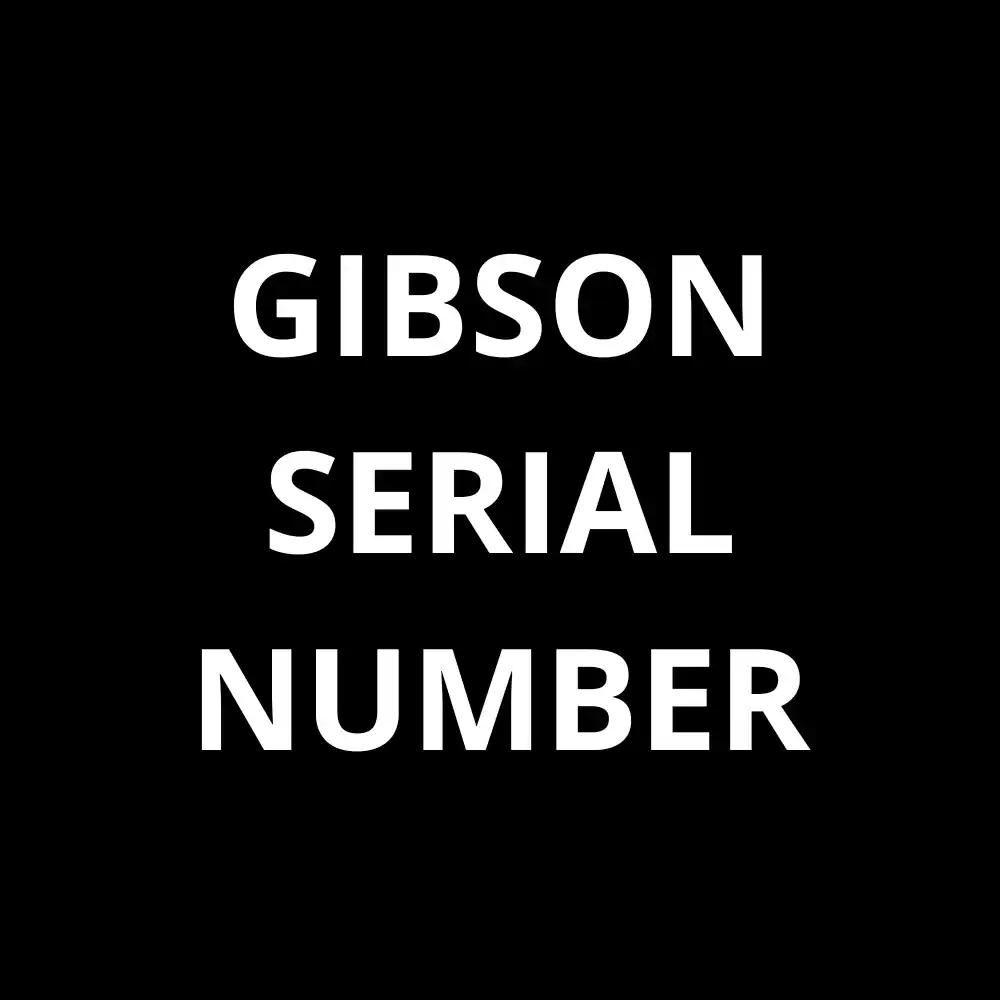How Old Is My Gibson? Serial Number Database
Want to know the true value of your guitar? Gibson serial number can help you find the production date, country, and even the factory where your instrument was made.
Table of Contents
We have collected extensive data on Gibson serial numbers for dating and telling the history of your guitar. Whether you want to verify an old Les Paul or vintage L-5, maybe a Gibson SG, Firebird, Explorer, Flying V, Hummingbird, The Paul, or any other model, our database uncovers the info you need.
Gibson is known for having the most duplicated serial numbers and has used different numbering systems since 1900, making it challenging to determine the production year based only on the serial number. Between 1902 and 1976, Gibson instruments were assigned a serial number, a Factory Order Number (FON), or both. However, this practice was not always consistent, resulting in some instruments without any serial number identification.
You can find Gibson serial number stamped or punched on the back of the headstock or inside the sound hole on acoustic guitars. The acoustic models have been produced in Bozeman, Montana since 1989.
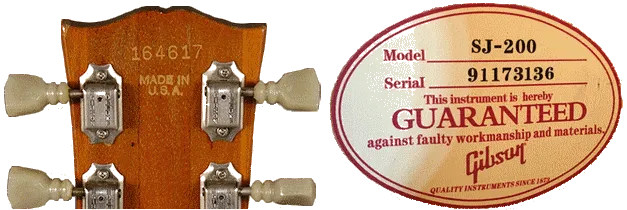
See also
Gibson Serial Number Database
Gibson Vintage Serial Number 1935-1941
The first Gibson serial number – Factory Order Number (FON) consists of a batch number of usually 4 digits, followed by one letter (sometimes prefixed by a space) followed by one or two digits (ranking).
• 1935-1937: Letter between the batch number and the order number (e.g., 0123 A5)
• 1938-1941: Two or three letters before batch number. The first letter is the year. If there is a second character following it is the code for the type of the instrument (G = Gibson, K = Kalamazoo, W Recording King (Montgomery Wards).
If follows there is a third letter E, which stands for Electric.
• Exceptions: Some high-end models and lap steels from 1939-1940 have added the letter A, to the prefixes D, E, or F.
Gibson Serial Number (FON) CHART – 1935-1941
| 1st Letter | Production Year |
|---|---|
| A | 1935 |
| B | 1936 |
| C | 1937 |
| D and DA | 1938 |
| Ex (x = any letter) | 1939 |
| F and FA | 1940 |
| E (no sequel letter) | 1941 |
| G | 1941 |
| H | 1942 |
Gibson Serial Code 1952-1961 – Factory Order Number
The letter preceding the serial number in the FON, and indicates the year of production. The serial number is the first 4 digits of the FON, followed by a one or 2-digit number. This letter must be before the FON serial number (e.g., Y1234 23).
This was done on archtop models from 1952 to 1961 and is stamped on the inside of the F-hole.
On flat tops, it was stamped on the neck block.
Gibson FON Number CHART – 1952-1961
| FON | Production Year |
|---|---|
| Z | 1952 |
| Y | 1953 |
| X | 1954 |
| W | 1955 |
| V | 1956 |
| U | 1957 |
| T | 1958 |
| S | 1959 |
| R | 1960 |
| Q | 1961 |
Gibson USA Serial Number – 1952-1961
Gibson‘s solid body guitars were released in 1952. Gibson did not use serial numbers at that time but started in 1953.
The first digit of the serial number is the last digit of the year. If the stamped numeral consists of 5 digits, there is a space between the first and second digits (a separation between the last digit of the year and the actual serial number).
If it concerns a 6-digit serial number, there is no space, because the highest 4-digit number (9999) has been exceeded and the space therefore fills up. This was the case in the years 1955, 1956, 1959 and 1960.
In 1955, Gibson forgot to reset the series of serial numbers to 0001.
So they had only set the year from 4 to 5. For this reason, the series of 4-digit serials was exceeded after 9999.
Hence 5 digits and no space between the year (5) and the serial number (after 5 9999 came 510 000).
The production was high in 1956 because 6 9999 was exceeded. Also in 1959 and 1960, there was a high production, 9 9999 is exceeded to 932 000 or higher.
Thus, from the production in 1959, a 1, 2, or 3 may be the second digit.
Gibson stopped the stamped serials at the end of 1960, although a few instruments were made in 1961 with a “1” as a prefix. Some lapsteels and Les Paul‘s from 1961 have such a serial number.
Another exception to the above rules is in the fall of 1958 when some Les Paul Junior and Special had a 4-digit serial number.
Gibson Serial Number Chart – 1952-1961
| 1st Letter | Production Year |
|---|---|
| None | 1952 |
| 3 | 1953 |
| 4 | 1954 |
| 5 | 1955 |
| 6 | 1956 |
| 7 | 1957 |
| 8 (at the end of 1958, a lot of LP Juniors/Specials had a 4-digit serial number without a prior annual digit) | 1958 |
| 9 | 1959 |
| 0 | 1960 |
| 1 (rare) | 1961 |
5 and 6-digit Serial Numbers – 1961-1970
Gibson started in 1961 with a new series numbering system. They wanted to apply a more structured series of sequences, but in practice, the opposite happened. Numerals were reused during this period, and in many cases, the numerals were not strictly applied for successive years.
For all models, the serial number is stamped on the back of the headstock. Gibson’s headstock serial was duplicated from 1963 to 1969.
From this period the 5-digit and 6-digit serial numbers are easy to confuse and give an incorrect year.
Gibson headstock Serial number Chart – 1961-1972
| 1st Letter | Production Year |
|---|---|
| 0100 – 42440 | 1961 |
| 42441 – 61180 | 1962 |
| 61450 – 64222 | 1963 |
| 64240 – 71040 | 1964 |
| 71041 – 96600 | 1962 (some 1963 and 1964) |
| 96601 – 99999 | 1963 |
| 000001 – 099999 | 1967 (all 6-digit numerals starting with 0. are 1967) |
| 100000 – 106099 | 1963 or 1967 |
| 106100 – 106899 | 1963 |
| 109000 – 109999 | 1963 or 1967 |
| 110000 – 111549 | 1963 |
| 111550 – 115799 | 1963 or 1967 |
| 115800 – 118299 | 1963 |
| 118300 – 120999 | 1963 or 1967 |
| 121000 – 139999 | 1963 |
| 140000 – 140100 | 1963 or 1967 |
| 140101 – 144304 | 1963 |
| 144305 – 144380 | 1964 |
| 144381 – 149864 | 1963 |
| 149865 – 149891 | 1964 |
| 149892 – 152989 | 1963 |
| 152990 – 174222 | 1964 |
| 174223 – 176643 | 1964 or 1965 |
| 176644 – 250335 | 1964 |
| 250336 – 305983 | 1965 |
| 306000 – 310999 | 1965 or 1967 |
| 311000 – 320149 | 1965 |
| 320150 – 320699 | 1967 |
| 320700 – 329179 | 1965 |
| 329180 – 330199 | 1965 or 1967 |
| 330200 – 332240 | 1965, 1967 or 1968 |
| 332241 – 348092 | 1965 |
| 348093 – 349100 | 1966 |
| 349121 – 368638 | 1965 |
| 368640 – 369890 | 1966 |
| 370000 – 370999 | 1967 |
| 380000 – 385309 | 1966 |
| 390000 – 390998 | 1967 |
| 400001 – 406666 | 1966 |
| 406667 – 409670 | 1966 – 1968 |
| 409671 – 410900 | 1966 |
| 410901 – 419999 | not known |
| 420000 – 429193 | 1966 |
| 500000 – 500999 | 1965, 1966, 1968 or 1969 |
| 501009 – 501600 | 1965 |
| 501601 – 501702 | 1968 |
| 501703 – 502706 | 1965 or 1968 |
| 503010 – 503109 | 1968 |
| 503405 – 520955 | 1965 or 1968 |
| 520956 – 530056 | 1968 |
| 530061 – 530850 | 1966, 1968, or 1969 |
| 530851 – 530993 | 1968 or 1969 |
| 530994 – 539999 | 1969 |
| 540000 – 540795 | 1966 or 1969 |
| 540796 – 545009 | 1969 |
| 555000 – 557999 | 1966 |
| 558000 – 567400 | 1969 |
| 570087 – 570643 | 1966 |
| 570645 – 570755 | 1966 or 1967 |
| 570857 – 570964 | 1966 |
| 580000 – 580080 | 1969 |
| 580086 – 580999 | 1966, 1967 or 1969 |
| 600000 – 600998 | 1966, 1967, or 1968 (low-end models) |
| 600000 – 606090 | 1969 (high-end models) |
| 700000 – 700803 | 1966, 1967 or 1969 |
| 750000 – 750999 | 1968 or 1969 |
| 800000 – 800999 | 1966, 1967, 1968 or 1969 |
| 801000 – 812838 | 1966 or 1969 |
| 812900 – 819999 | 1969 |
| 820000 – 820087 | 1966 or 1969 |
| 820088 – 823830 | 1966 |
| 824000 – 824999 | 1969 |
| 828002 – 847488 | 1966 or 1969 |
| 847499 – 858999 | 1966 or 1969 |
| 859001 – 891999 | 1967 |
| 892000 – 896999 | 1968 |
| 897000 – 898999 | 1967 or 1969 |
| 899000 – 899999 | 1968 |
| 900000 – 909999 | 1970 |
| 910000 – 999999 | 1968 |
6-digit Serial Number – 1970-1975
From 1970 to 1975 the 6-digit Gibson serial numbers were randomly created. In a random order, serials were stamped on the back of the headstock. With some instruments preceded by a letter. In 1970 the orange labels inside the body of acoustic guitars were replaced by white with orange rectangular labels.

The electric models were provided with a rectangular with a black and purple triangle.
From 1970 “MADE IN USA” was also stamped on the back of the headstock. Some instruments from the fifties also had such a stamp.
After production continued by Gibson’s new company Norlin (1969-1986), the same confusing 6-digit serial system from the 1960s continued until 1975.
This means that instruments with the same Gibson serial number were produced either in the 1960s or 1970s.
Guitars got six digits in random order, and in some cases, they were preceded by a letter that did not seem to have meaning.
Note that Gibson serials between 1970 and 1975 may be a repeat of the serial numbers from 1964 and 1965. In 1970 some 6-digit serials had the letter A as a suffix.
The table below shows the years to which the serial numbers can relate.
GIBSON headstock SERIAL NUMBER chart – 1970-1975
| Serial Number Range | Production Year |
|---|---|
| 000000 – 099999 | 1973 |
| 100000 – 199999 | 1970 – 1975 |
| 200000 – 299999 | 1973 – 1975 |
| 300000 – 399999 | 1974 – 1975 |
| 400000 – 499999 | 1974 – 1975 |
| 500000 – 599999 | 1974 – 1975 |
| 600000 – 699999 | 1970 – 1972 and 1974 – 1975 |
Gibson Limited Edition Serial Number
The limited editions from 1975 to 1977 have a gold-colored serial number and imprint “Made in USA“. These serials are preceded by 2 digits. 99 = 1975, 00 = 1976 and 06 = 1977.
8-digit Serial Number (Since 1977)
Gibson’s most sustainable numbering system was launched in 1977, an 8-digit serial number. The first and fifth digits represented Gibson’s year of manufacture. The three intervening digits, the day of that year. The digits 6 to 8 indicated the sequence numeral.
Example: 80923015
80923015 is 1983, day 092 (day 92 of 1983 is 2 April), production number 015.
After the opening of the new factory in Nashville, production was also included in the serial numbers. 001 to 499 appeared on instruments built in Kalamazoo, 500 to 999 built in Nashville.
Even after the Kalamazoo plant closed in 1984, this process continued until 1989 in Nashville.
In July 2005 this 8-digit system was updated by adding 1 digit. The 6th digit is now the batch number, and the last 3 digits are the sequence number of the batch. The sequence numeral runs from 500 to 699.
Example: 113142030 is the 30th instrument from batch 4 of May 11, 2014.
When 699 is reached the batch number is incremented by 1, and the sequence number is reset to 500.
This coding system was used until 2014.
This system was changed again at the beginning of 2014. The day and batch number were no longer included in the serial number. The Gibson serial number now consists of 9 digits, the first 2 of which indicate the year and the next 7 digits the sequence numeral.
160001234 is the production year 2016 with sequence number 0001234.
Gibson closed the Memphis plant in April 2019. The production of “USA-made” solid body guitars is now only produced in Nashville.
Dating Gibson by Potentiometers
If you can not find your Gibson serial number, you can approximate the age of a semi/electric guitar based on the potentiometers.
The code on potentiometers gives information about the manufacturer and the year and week when it is made.
Gibson Headstock Logo Dating
The Gibson logo can also indicate the year of construction (approximately).
The first logo (1902-1920) on Gibson’s guitars was in italic typeface, inlaid with pearl. Some specimens from 1903 to 1907 were not oblique or had no logo at all.
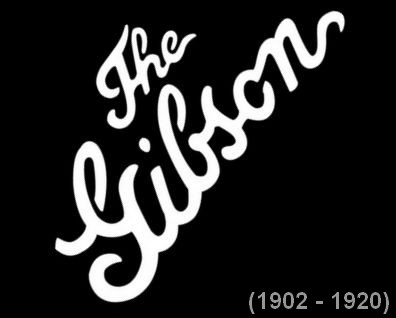
During the period from the end of the 1920s to 1933, the logo was no longer placed obliquely. From some flattop guitars from this era the word “The” was omitted from the logo.
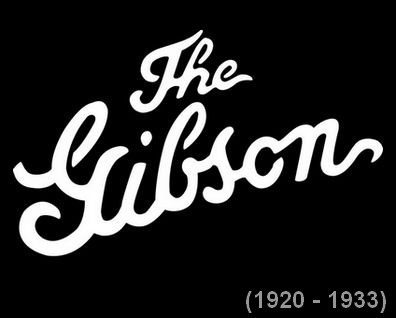
From the end of 1933 to 1943, Gibson had omitted the “The” of all their logos. The original thin letters were replaced after 1933 by a thicker font.

From 1943 to 1947 the logo was printed in thick gold, also called the banner logo. Some models, such as the LG-2 and the L-50s, have a real banner in the middle of the headstock with the text “Only a Gibson Is Good Enough”.
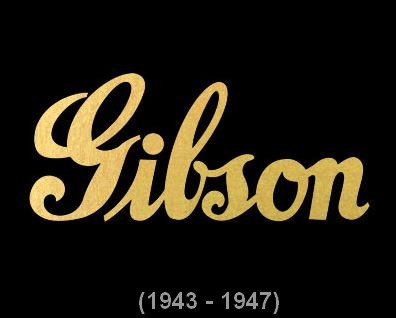
The block logo made its appearance after World War II and is still the face of Gibson to this day. Between 1968 and 1981 the dot on the “i” was omitted on some guitars. Most models get a dot on the “i” again in 1972, the rest follows from 1981.

